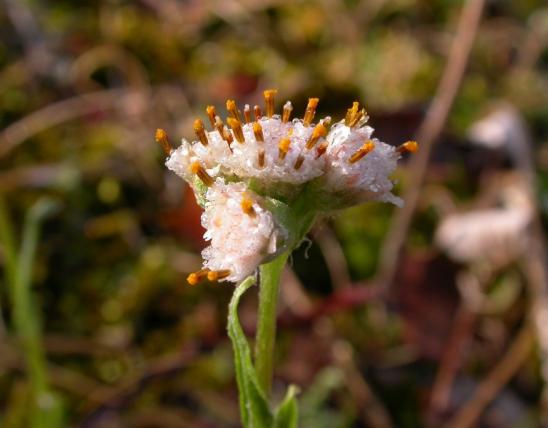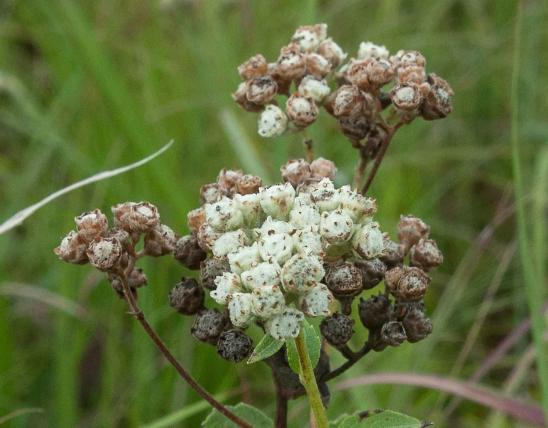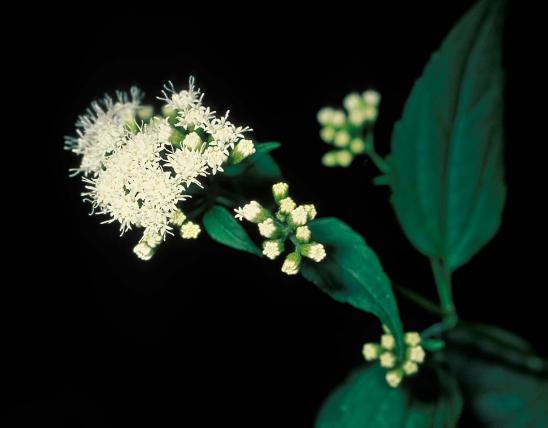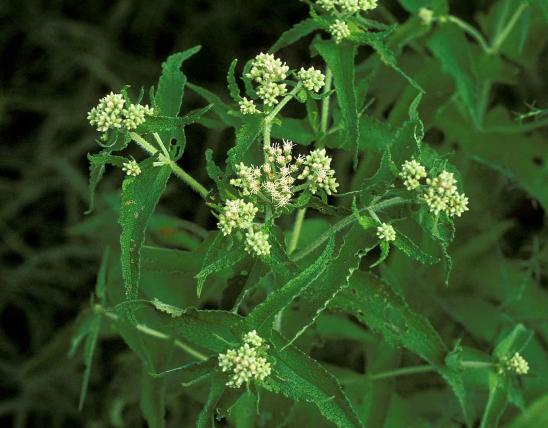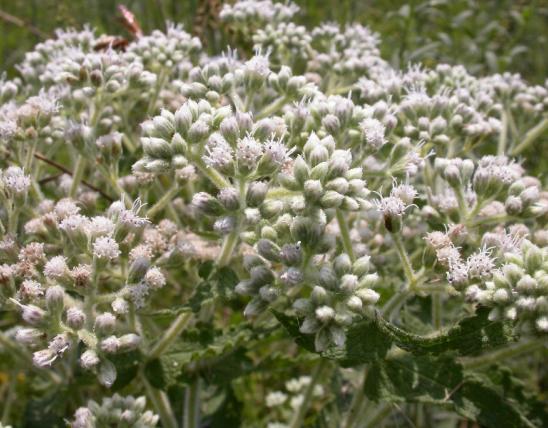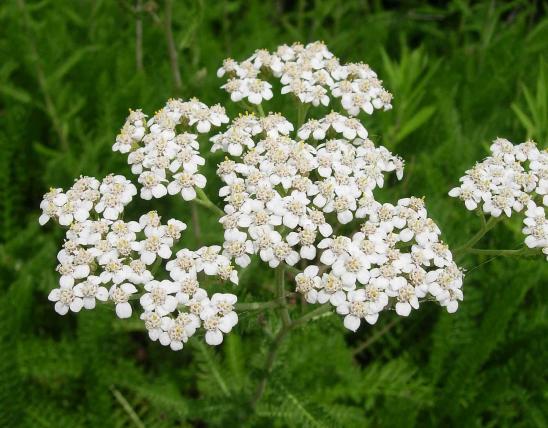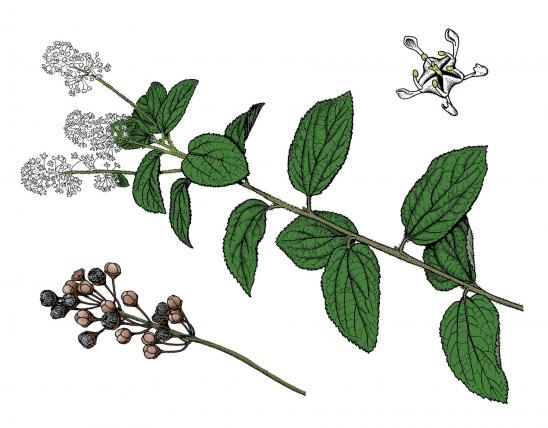
Sweet everlasting, or old field balsam, catches your eye with its clusters of white, peg-shaped flowerheads and white branches that contrast with the narrow green leaves. It occurs statewide, in a variety of open, sunny habitats.
Sweet everlasting is an annual or biennial, nonwoody plant with upright stems that look white because they are covered with dense, woolly or feltlike hairs. The leaves are alternate, stalkless, narrow, lance-shaped, and toothless; the upper sides are green, but the undersides look white due to woolly hairs. The white, broad-spreading branches at the top of the plant bear small, pale yellow or white flowerheads of tightly packed florets surrounded by white, papery bracts. Blooms July–November.
When the flowerheads mature, the bracts spread open to release a fuzzy cluster of seeds: each tiny seed (achene) is topped with a pappus of silky hairs, which allows them to blow away in the wind. Once the seeds are gone, the empty receptacle, still surrounded by the outspread dry, papery bracts, looks something like a little flower itself.
Despite several of the common names, this plant is only slightly aromatic when bruised or crushed. Some describe it as similar to maple syrup; the dried foliage tends to have a stronger scent.
Similar species: The smooth, mature rosettes of basal leaves of old field balsam may be confused with pussytoes, especially plainleaf pussytoes (Antennaria parlinii). Note that the upper surfaces of sweet everlasting’s basal leaves have scattered, minute stalked glands. Also, sweet everlasting is taller than both our pussytoes species.
Pearly everlasting (Anaphalis margaritacea) is cultivated as an ornamental in gardens and is used for fresh-cut and dried flower arrangements. It is native to the western and northern United States but not to Missouri, though it has been recorded growing out of cultivation in a few locations; it has much wider, showier flowerheads than sweet everlasting.
Missouri has two other species in the genus, both called “rabbit tobacco”; both are uncommon. In both cases, the stems are not woolly below the flower clusters in mature plants; at most, they may be only glandular or glandular-hairy. Both are usually strongly aromatic when bruised or crushed. P. micradenium is known only from Shannon and Ste. Genevieve counties, in open, dry, upland semi-wooded areas. P. helleri is known from only a single, historic collection from St. Louis County, where it might have been introduced. Both of these species are listed as Missouri species of conservation concern and tagged as “unrankable,” due to a lack of information or about their status or trends.
Height: ½–3 feet.
Scattered nearly statewide.
Habitat and Conservation
Occurs in upland prairies, openings of upland forest, savannas, glades, tops of bluffs, and banks of streams and rivers; also in pastures, old fields, railroads, roadsides, and other open, disturbed areas.
Status
Native Missouri wildflower.
Related to pussytoes (Antennaria spp.) and cudweeds (Gamochaeta spp.). Plants in tribe Gnaphalieae of the aster family are often called everlastings, rabbit or Indian tobacco, cudweeds, pussytoes, and/or catfoot.
Life Cycle
Sweet everlasting can complete its life cycle within a single growing season (as an annual plant) or two (as a biennial). As an annual, it may grow and develop flowers and seeds within a single growing season. But as a biennial plant, sweet everlasting can produce a rosette of basal leaves during its first growing season, overwinter in a dormant state, then, the next spring, resume growth and finally produce the stalk bearing the flower clusters and seeds. The plant then dies upon the first hard freezes.
Human Connections
Across its wide range in eastern North America, everywhere this plant grows, the indigenous people discovered uses for it. Native Americans utilized nearly every part of the plant for an impressive range of medical and spiritual applications and more. It was used in decoctions and infusions, steamed as an aromatic, chewed, smoked as an inhalant, and burned as a smudge.
White settlers learned of these uses and found more. The aromatic qualities of dried sweet everlasting inspired its use as a freshener and moth repellent where clothes were stored.
The name “cudweed” is used for several kinds of plants. Plants bearing the name usually have a history of being used medicinally to treat cattle that had lost their ability to chew their cud (ruminate). Meanwhile, some plants called cudweed may simply resemble plants used in this way. Because sweet everlasting produces saliva flow if you chew it, it’s likely that it was used in the same way for cattle.
Ethnobotany is the study of human interactions with plants, and it’s a rich and rewarding field, combining anthropology, history, agriculture, botany, biogeography, and more. Humans rely on plants for food, beverages, medicine, building materials, fiber, tools, fodder, and more, and every human culture on earth has had fascinating, unique relationships with plants.
The species name, obtusifolium, means “blunt-leaved.” It does not seem to be a particularly good name for this plant, whose narrow stem leaves taper to a reasonably pointed tip. The felty, tomentose leaves of the basal rosette, however, are reverse-lance-shaped to narrowly elliptic and have relatively rounded, or blunter tips. The rosettes of basal leaves are most visible in early spring.
Ecosystem Connections
Several types of pollinators visit sweet everlasting, including bees, flies, and many kinds of wasps.
Both deer and wild turkey consume the foliage.
The American lady butterfly (Vanessa virginiensis) uses sweet everlasting and its close relatives as caterpillar food plants. Females lay eggs (usually singly) on the leaves of the plant, and upon hatching, the caterpillar feeds on the leaves, safe inside a tent it builds of silk and the leaves of the plant. American lady caterpillars are typically black with yellowish crossbands, black, branching spines, and white spots on the sides of the abdominal segments. If you see one chewing on a sweet everlasting plant, you’ll know what it is!
As a member of America’s native grasslands, sweet everlasting plays a role in an intricate ecosystem where hundreds of species of nonwoody plants can occur within a relatively small patch of ground. The diverse flora of a tallgrass prairie supports a surprising variety of insects, birds, reptiles, mammals, and other animals, many of which are specialized to live nowhere else.


























